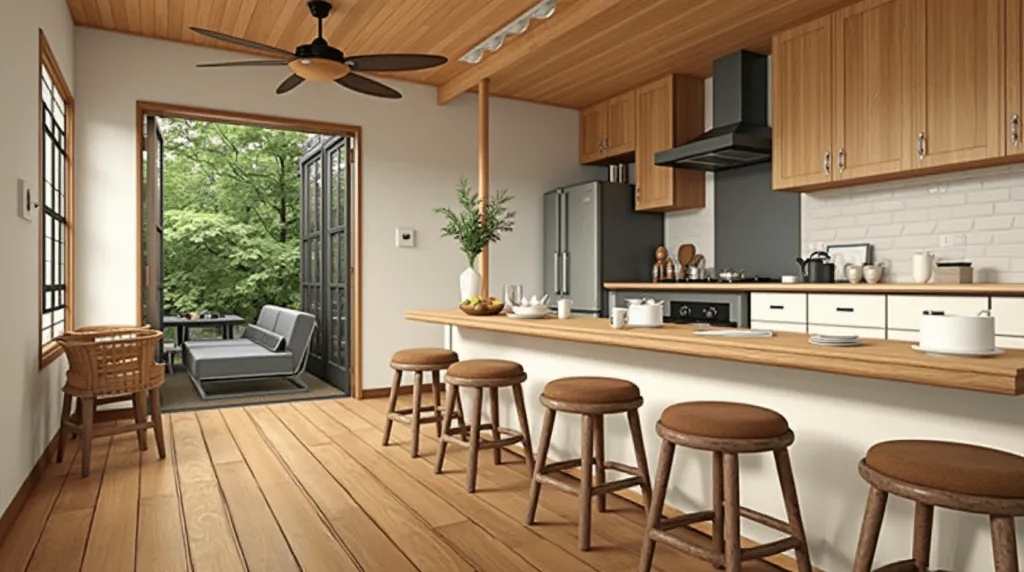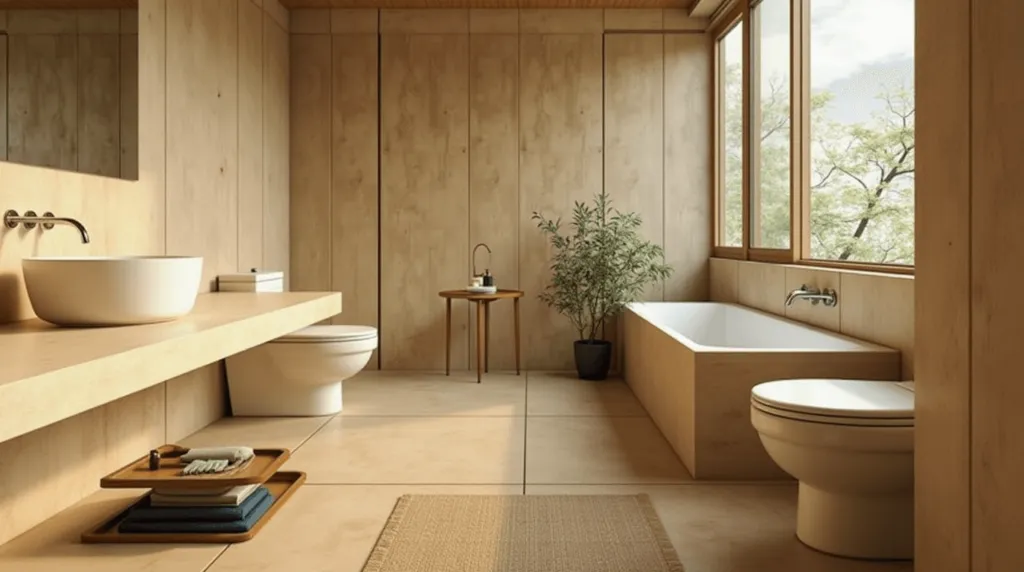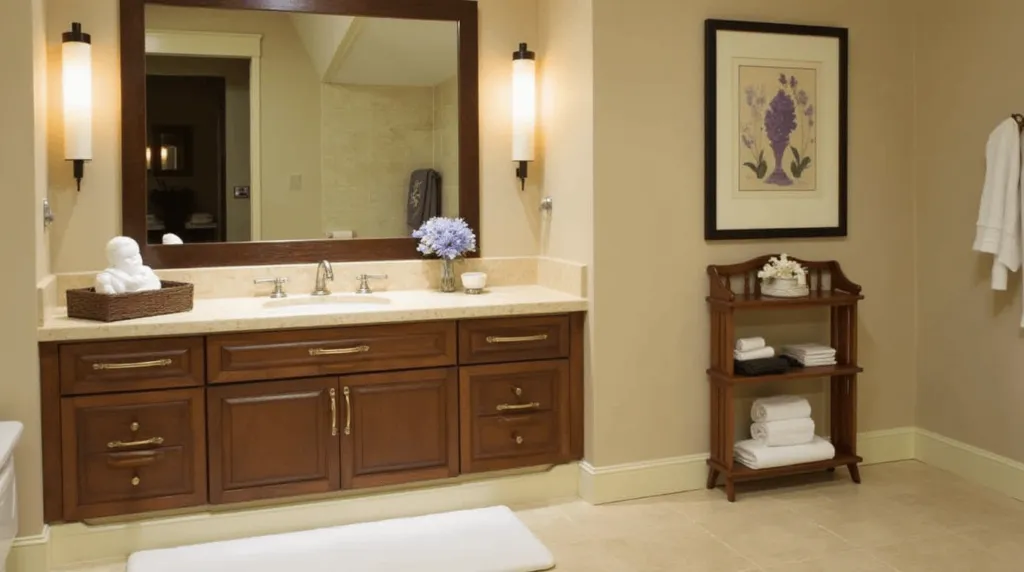Japanese Home Decor: How to Create a Peaceful and Minimalist Sanctuary

A Philosophy of Simplicity and Harmony
Table of Contents
Japanese home decor is deeply rooted in the concepts of Zen and wabi-sabi. These philosophies promote living with less, embracing imperfection, and connecting with nature. The spaces are uncluttered, the lines are clean, and the materials are raw and honest—wood, paper, stone, and fabric.

The Five Core Principles
1. Minimalism
Focus on what matters. Keep only meaningful items, and remove visual clutter.
2. Nature
Bring the outside in: natural light, indoor plants, bamboo, and organic textures.
3. Clean Lines
Simplicity in architecture and furniture—straight lines, right angles, calm symmetry.
4. Balance
A balance of light and shadow, space and object, warm and cool tones.
5. Functionality
Everything has a purpose. Storage is smart, design is intentional.
Japanese Style by Room



Living Room – Tranquility First
In Japanese culture, the living room isn’t just for lounging—it’s a place for reflection, connection, and grounding energy. To create this atmosphere, it’s essential to start with a low-to-the-ground layout. Traditional chabudai tables (short-legged wooden tables) encourage floor seating and an informal, open setting. Add zabuton (flat cushions) or floor chairs to complete the look.
Avoid over-furnishing. Instead of bulky sofas and decorative overload, keep one or two statement pieces such as a bonsai tree, a stone sculpture, or a minimal ink wash painting. Walls should remain bare or feature clean-lined shelving, often made from natural wood. A shoji screen, with its translucent washi paper panels, adds both elegance and function—offering a sense of privacy without cutting off light.
When it comes to lighting, soft, warm glows are key. Use washi paper lanterns or wooden lamps with a dimmer to gently illuminate the room. This creates a calming ambiance that’s ideal for meditation, reading, or simply unwinding.
Bedroom – A Restful Retreat
The Japanese bedroom is a space of repose and restraint. Clutter, electronics, and excessive textiles are out; clarity and natural beauty are in. Start with a low-profile bed—a futon mattress placed on a simple wooden frame or even directly on tatami mats. This reduces visual noise and reconnects you with the earth, in both metaphor and practice.
Choose natural fibers for bedding, such as undyed linen, soft cotton, or even bamboo. Stick with neutral colors: off-whites, soft greys, and muted browns dominate the palette. This is not a space for bold patterns or excessive color play.
Introduce subtle storage solutions like built-in closets or under-bed drawers to keep the room tidy and serene. For ambiance, scented elements such as cedarwood incense or a green tea diffuser can help relax the senses. Add a paper lantern on a bedside table and keep decorative elements to a minimum—a single flower in a ceramic vase can say more than an entire gallery wall.
Bathroom – Spa-Like Serenity
Japanese bathrooms are inspired by onsen culture, where bathing is both ritual and relaxation. The goal is to create a space that feels like a private spa—clean, minimal, and deeply soothing.
Incorporate natural materials wherever possible: wooden elements like hinoki (Japanese cypress) add warmth and a fresh scent; stone sinks and countertops evoke a connection with earth and water. The idea is to blend function with form, where every item looks beautiful and serves a purpose.
A deep soaking tub (ofuro) is the centerpiece of a traditional Japanese bathroom, but even without one, you can create a similar atmosphere by keeping lines clean, using monochrome tiles, and selecting organic textures. Avoid plastic where possible—opt instead for bamboo accessories, glass containers, and brushed metal fixtures.
Soft lighting and natural aromas (lavender, hinoki, or yuzu) transform even the simplest bathroom into a space of healing and stillness. Add a rolled towel stack, a wooden stool, and some river stones or pebbles for an added spa touch.
Kitchen & Dining – Function Meets Elegance
The Japanese kitchen emphasizes order, cleanliness, and gratitude—all grounded in the concept of “mottainai,” a deep respect for not wasting anything. Start by simplifying your storage: open shelves, organized drawers, and minimal countertop items ensure that the space feels airy and light.
Use dishware as a design feature. Choose handmade ceramics, lacquered bowls, bamboo chopsticks, and cast iron teapots. These aren’t just functional—they’re beautiful, tactile objects that elevate the everyday.
In the dining area, opt for a low table or sleek wooden one with simple lines. A single plant, a stone tray, or a kintsugi-style bowl (repaired with gold to highlight imperfections) make for meaningful, intentional centerpieces.
Create a setting that encourages mindful eating: no screens, no noise, just attention to the meal and the people you’re sharing it with.





Essential Elements of Japanese Decor
| Element | Description | Suggested Use |
|---|---|---|
| Shoji Screens | Lightweight room dividers with washi paper | Divide rooms, filter light |
| Tatami Mats | Straw-based mats traditionally used for flooring | Bedrooms, meditation areas |
| Washi Lamps | Paper lanterns that diffuse light softly | Living room, bedroom lighting |
| Indoor Plants | Bring calm and balance through greenery | Bonsai, bamboo, snake plant |
| Natural Wood | Raw, organic, and warm in tone | Furniture, shelves, beams |
| Zen Art & Calligraphy | Simple, minimal, and evocative of mindfulness | Wall art, scrolls, framed pieces |
Shop the Look – Japanese Essentials
- Shoji Screen Divider – [Amazon / Wayfair]
- Tatami Mat for Small Spaces – [ManoMano]
- Bonsai Tree Kit (Beginner-Friendly) – [Amazon]
- Minimalist Washed Linen Bedding – [Affiliate Link]
- Cast Iron Japanese Teapot Set – [Wayfair]
- Washi Paper Floor Lamp – [Amazon]
FAQ – Japanese Home Decor
1. Is Japanese home decor expensive to implement?
Not necessarily. While some authentic items (like handcrafted tatami mats or artisanal ceramics) can be pricey, the principle of minimalism makes it more affordable overall. You buy fewer items, but more intentional ones.
2. What colors are best for a Japanese-inspired home?
Stick with earthy tones: beige, ivory, soft gray, natural wood, charcoal, muted greens. Bright colors are rarely used unless it’s for a natural accent like a bonsai or a single red flower.
3. Can I mix Japanese decor with other styles?
Yes—Japandi (Japanese + Scandinavian) is a popular fusion style. You can also blend with minimalist modern elements, as long as you respect the simplicity and balance at the heart of the design.
4. How do I start small with Japanese decor?
Start with one room or one element: a bamboo plant, a floor lamp, or a low wooden table. Declutter your space and choose materials that feel good to the touch. It’s all about intentional living.
Final Thoughts
Japanese home decor isn’t about following a design trend—it’s about shifting how we live. It invites you to slow down, reduce excess, and create a space that restores your energy instead of draining it.
Whether you’re remodeling an entire room or adding a few thoughtful pieces, this style offers a timeless elegance that never overwhelms. And in today’s world, that kind of peace is more valuable than ever.
